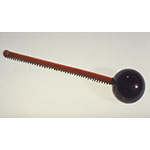This thermometer has a spherical bulb. The thermometric liquid was dyed with ox blood, as shown by the red traces on the thermometer. Because of the transparency of acquarzente, the level of the liquid in the pipe was not easy to read. Therefore, as specified by Lorenzo Magalotti in Saggi di naturali esperienze [Examples of Natural Experiments] (Florence, 1667), "it is sometimes the practice to dye it with infusion of crimson or of that liquid which is commonly called sangue di drago [dragon's blood]." This thermometer is divided into fifty degrees, one of the many thermometric scales adopted by the Accademia del Cimento. The degree marks on the stem are of enamel; the black dots indicate single degrees, the white dots ten degrees. Invented by Grand Duke Ferdinand II de' Medici, fifty-degree thermometers were generally used to measure the variations in heat and cold of the air, both outdoors and indoors. The academicians made extensive use of the instrument, chiefly for meteorological observations: the advantage of these thermometers was that their readings were comparable with one another, even though they were not the most sensitive.










